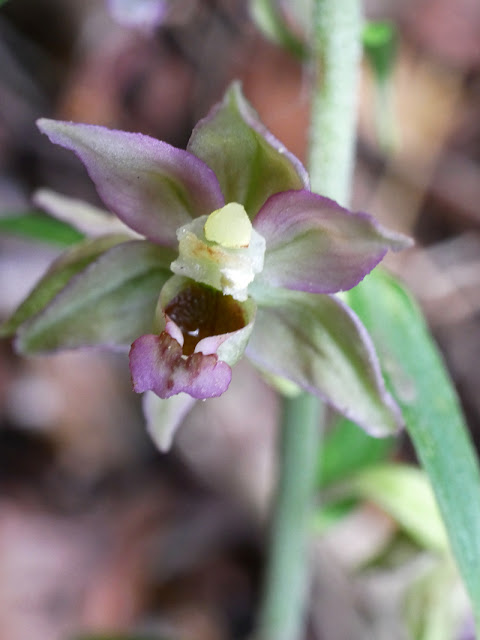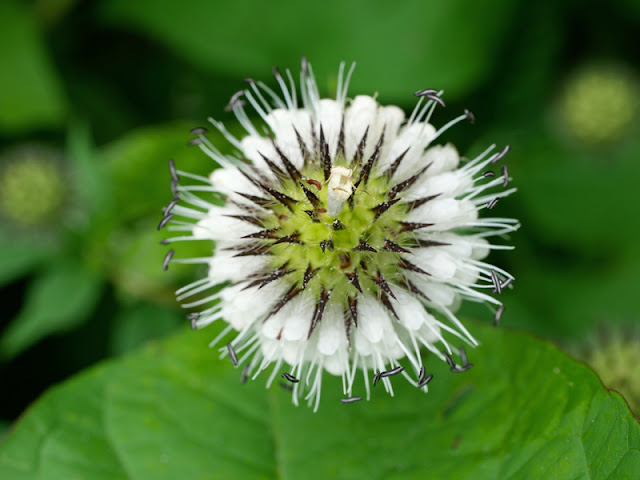August 2021 - Botanical Finds from Kent
It's November as I write this, which is a shame. I would prefer to keep my blogs current so you, the reader, can go out and try and find some of the amazing wildflowers I come across too. However, life conspires against me to keep things like this blog up to date. So instead, look at this as either nostalgic of the season now gone, or as inspiration for planning a trip next Summer to find such plants for yourself. Either way, I hope you enjoy reading this blog and gain some inspiration for the wonders of the natural world on our doorstep.
By the time August comes along, most or our wild orchids have come and gone, but Violet Helleborine may still be found in flower. Most years, I find new colonies in suitable woodland habitats around the county. Here, I found 3 plants with a few flowers still open on a road verge on Pembury Walks. Nearby, were also some Broad-leaved Helleborines still in flower too, also a new find for the monad.
Epipactis purpurata
This is Toad Rush (below), a small, mat making plant with tiny star like flowers. This is the freshest one I've yet seen and the mat had hundreds of such flowers. When looking for them, bear in mind the plant rarely makes 6" in height and is low growing.
Juncus bufonius
It's great to see a touch of Spring in late Summer! Here's a Wood Dog Violet in flower in August. This is not uncommon, but still rare enough to raise a smile when I see one. Common Dog Violet also sometimes flowers now too. It's now been discovered that they also produce flowers underground late in the year and they set seed underground too. Quite an incredible plant really.
Viola reichenbachiana
Wild Strawberries are quite a common find in the wild in Kent. Not so common is the Yellow Strawberry. This is a garden plant that has escaped in a few places into the wild. It had escaped here from an unknown garden and lined about 100m of a rural road verge near Pembury. I've seen these naturalised at Port Lympne zoo as well. Of course, the flower is what is yellow, not the fruit.
Potentilla indica
Chickory has attractive bright blue flowers and is a Kent RPR species. It is reasonably common locally to me in North Kent and here it is growing happily with Wild Parsnip near Longfield.
Cichorium intybus
Nearby to those plants was another Kent RPR species, Small Teasel. The east side of Hartley Woods probably has the largest population of this plant in Kent with thousands of plants present. It is likely the site will be developed for housing within a few years. There is no protection for them.
Dipsacus pilosus
A trip to Sheppey on 08/08/21 and I found this Cut leaved Dead Nettle. It looks different to Red Dead Nettle in that it rarely has more than 2-3 flowers open at any one time. They are smaller than usual and of course, the leaves are much more dissected than usual too.
I picked a leaf to show the dissected nature of them more clearly.
Lamium hybridum
Some Catmint was found on a rural road verge. I didn't photograph the whole plant as it had recently been squashed as a tractor had run them over! The plant was still alive, so likely to set seed.
Nepeta cataria
On the 12th August I attended a field trip with the Kent Botanical Recording Group to record the NT Sissinghurst esate. A new plant for me was Chaffweed, a small plant that is prostrate and is a lookalike to Scarlet Pimpernels or possible Common Chickweed when flowers aren't present. However, Sue Buckingham kindly showed me what to look for, for a quick identification. Most leaves have an edging of black dots. You can see these on the upper leaves in the photo. Hopefully, I might find some in flower too.
Lysimachia minima
Water Purslane is another small plant that likes acid soils. It produces flowers and then seeds (as shown below) in the leaf axils. It's small and low growing and is usually in very damp areas. It likes wet tractor ruts that's for sure.
Lythrum portula
My final field trip with the Kent Botanical Recording Group to Sissinghurst, before I move out of the area. It was sad to say goodbye, but everything moves on.
The star find (though expected) was of a few patches of flowering Ivy-leaved Bellflower, a rare plant and one I'd not seen before. I was struck by how small the flowers were. One would likely notice the odd shape of the leaves before even seeing a flower. The flowers were like miniature Harebells to which they are of course related.
The plant intertwining them below are the leaves of Yellow Pimpernel (Lysimachia nemorum)
Wahlenbergia hederacea
Habitat, showing the recent coppicing and rapid re-growth of Betula species.
Common Cow-Wheat is a rare plant and hard to find, so it's nice to stumbe across some. This was in an area of woodland near Sissinghurst with virtually no under story plant community at all. Handy then that they parasitise woody species. Holly and Common Oak were nearby.
Melampyrum pratense, ssp pratense
Greater Burnet Saxifrage grew in abundance on a rural road verge near Sissinghurst. The purple flowers are Purple Loosestrife (Lythrum salicaria).
Pimpinella major
Near the end of the month, I visited the area of the Medway Bridges near Cuxton. On rabbit scraped chalk turf, I found some Basil Thyme, another rare plant in Kent and quite tiny.
Clinopodium acinos
The area shown below had thousands of Common Cudweed plants, an amazing amount. It is more usual to find perhaps a dozen or so plants.
Filago germanica
(previously Filago vulgaris)
If that wasn't spectacular enough, in amongst them were dozens of the new arrival on the block, Jersey Cudweed. Currently shown as rare, it won't be for long, as it is spreading throughout the county rapidly.
Laphangium luteoalbum
Another plant I have found more frequently of late in the area is Four Leaved Allseed. These were growing under the bridges themselves in a very dry area. I guess this was mimicking a block paving habitat which is where it is usually found.
Polycarpon tetraphyllum
It's not always about the plants. Here's a female Southern Hawker Dragonfly recently emerged and drying its wings near Tunbridge Wells at the end of August.
That about sums up August. Summer is usually enjoyable. Thankfully, in Kent it didn't get too hot to go out this year as it has in the recent past. I dread to think what it was like in Canada which had temperatures in excess of 50 degrees Celsius though. Let's hope this doesn't happen here!
I hope you enjoyed the blog and the remainder of the year will follow soon.
Take Care
Dave



































Are you moving? Out of Kent? If so, good luck.
ReplyDeleteYes, very soon. There is a new blog site for future finds in Cornwall. No more Lady Orchids!
DeleteRegards
Dave
New blog is at https://sylvatica2022.blogspot.com/ first post already published.
Delete